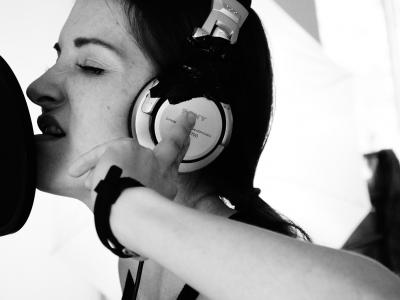This course is for the vocalist who wants to be a well-rounded jazz musician and not just a jazz singer. Throughout the course, you will build your understanding of the basics of jazz performance and language to build a strong foundation for advanced study.
This course highlights jazz singing icons, Ella Fitzgerald, Billie Holiday, Sarah Vaughan, Frank Sinatra, Nat “King” Cole, and Louis Armstrong, and includes analysis of their personal style, phrasing, repertoire, and history.
We will reconstruct our approach to singing by learning how to tell the story of a song through examination and analysis of the emotions revealed from the lyrics. We will deepen our knowledge of the blues scale and the blues form, learn blues songs within the jazz genre and improvisation material for solos, establish strong time and groove connections, develop scat vocabulary, learn to improvise, and finally, create a set list and put on a show.
By the end of the course, you will be able to:
- Sing the blues, a ballad, an uptempo jazz standard, a bossa nova, and a bebop head
- Navigate rhythm changes
- Improvise using scat syllables
- Tell a story using lyrics, improvisation, style, and emotion
- Emulate—but not imitate—great jazz singers, using their techniques to incorporate into your own unique sound
- Create an interesting standalone set list and one based on a theme or occasion
- Develop fodder for the “in between” in order to become comfortable communicating with the audience when not singing
Syllabus
Lesson 1: Storytelling
- The Elements of a Compelling Story
- Perspective
- Emotion
- Learning Your Song
- Delivery
- Are You an Engaging Storyteller?
- Assignment 1: Perform a Song of Your Choice
Lesson 2: The Blues
- History of the Blues
- Early Blues Development
- Blues Form and Blues Scale
- Workshop: Vocal Warm-up
- Blues Lines, Licks, and Patterns
- Singing Jazz Blues
- Assignment 2: Sing a Blues Song
Lesson 3: Groove: Time Keeping and Styles
- What is Groove?
- Rhythm
- What Happens if the Audience Gets the Beat Wrong?
- Time
- Swing
- Straight Eighths or Latin
- Funk
- Assignment 3: Straight Eighth Songs
Lesson 4: Ella, Billie, and Sara
- Uptempo Swing Songs
- Compare and Contrast Uptempo Swing Songs
- Singing a Ballad
- Compare and Contrast Ballads
- Performance
- Assignment 4: Perform One Uptempo Song and One Ballad
Lesson 5: Louis, Frank, and Nat
- Uptempo Swing Songs
- Compare and Contrast Uptempo Tunes
- Singing a Ballad
- Compare and Contrast Ballads
- Assignment 5: Perform One Uptempo Song and One Ballad
Lesson 6: Improvisation
- The Melody
- Words
- Rhythm
- Transcription
- Assignment 6: Improvise a Song
Lesson 7: The Circle of Fourths
- What Is It?
- Chords, Scales, and Patterns
- The ii-V7-I and the Circle of Fourths
- “All the Things You Are”
- Assignment 7: “All the Things You Are”
Lesson 8: Rhythm Changes
- “I’ve Got Rhythm”
- Rhythm Changes—a Very Common 32-Bar Chord Progression
- Improvising over the ii V7 I Chord Progression
- Improvising over I VI ii V7 Chord Progression
- Transcribe an Instrumental Rhythm Changes Solo
- Assignment 8: Perform a Bebop Head
Lesson 9: Building Your Repertoire, Part 1: The Jazz Age to the 1950’s
- The Jazz Age—the 1920s and ’30s
- The ’40s
- The ’50s
- Jazz in Hollywood in the ’50s
- Assignment 9: Perform a Song from One of the Eras Discussed
Lesson 10: Building Your Repertoire, Part 2: 1960’s to Today
- The 1960s and ’70s
- The ’80s
- The ’90s and early 2000s
- 2010 and Beyond
- Assignment 10: Assignment 8: Perform a Song from One of the Eras Discussed
Lesson 11: The Art of Vocalese
- What is Vocalese?
- Eddie Jefferson, King Pleasure, Jon Hendricks, Mark Murphy, and Kurt Elling
- Annie Ross, Sheila Jordan, Anita Wardell, and Veronica Swift
- Complex Harmony with Lambert, Hendricks & Ross, Manhattan Transfer, New York Voices, Singers Unlimited, and Take 6
- Writing Lyrics for a Vocalese
- Assignment 11: “Doodlin’” by Lambert Hendricks & Ross, “Moanin” by Anita Wardell, or “Those Clouds Are Heavy, You Dig”
Lesson 12: Performance
- Your Songs
- Creating an Interesting Set List
- Mic Technique
- Counting in a Tune with a Band
- Assignment 12: Final Project: 15-Minute Recital
Requirements
Prerequisites and Course-Specific Requirements
Prerequisite Courses, Knowledge, and/or Skills
Completion of Ear Training 1 or Basic Ear Training, Music Theory and Sight-Singing for Vocalists and Voice Technique 101 or equivalent knowledge and experience is required.
Students should:
- have studied vocal technique for at least one year
- know the major key signatures and scales
- have a healthy voice and be able to match pitch
- possess a strong sense of rhythm
- be familiar with the circle of fourths
- have rudimentary piano skills
Textbook(s)
- The Jazz Singer's Handbook by Michele Weir (Alfred Music, 2005)
- Recommended: Being a Singer: The Art, Craft, and Science by Linda Balliro (Chicago Review Press, 2019)
Recording
- Students are required to record video while performing with a backing track for their assignments. Options for recording video include:
- Smartphone
- Digital camera
- Webcam (using either video recording software, or the video recording tool that is built into the learning environment)
Hardware
- Students are required to capture their vocal performance in high quality, as well as monitor audio output. Options include:
- Input (one required):
- XLR microphone suitable for singing and audio interface (recommended option)
- USB microphone suitable for singing
- Output (one required):
- Headphones (required if multitracking and/or input monitoring)
- Studio monitors and audio interface
- Built-in or external speakers
- Input (one required):
- Note: Depending on your setup, you may also need an XLR cable, microphone stand, and pop filter.
Student Deals
After enrolling, be sure to check out our Student Deals page for various offers on software, hardware, and more. Please contact support@online.berklee.edu with any questions.
General Course Requirements
Below are the minimum requirements to access the course environment and participate in Live Classes. Please make sure to also check the Prerequisites and Course-Specific Requirements section above, and ensure your computer meets or exceeds the minimum system requirements for all software needed for your course.
Mac Users
PC Users
All Users
- Latest version of Google Chrome
- Zoom meeting software
- Webcam
- Speakers or headphones
- External or internal microphone
- Broadband Internet connection
Instructors
Author & Instructor
Jazz Times magazine states that “Patrice Williamson isn’t a singer, she’s a one-woman jazz sampler. – She is a woman of many voices, each distinctly intriguing all distinctly her own.”
A native of Memphis, Tennessee, Patrice Williamson is a jazz singer who swings hard and can scat with the best of them. She’s been rightly compared to Ella Fitzgerald and Sarah Vaughan in publications such as the Los Angeles Times and The All-Music Guide to Jazz.
A favorite of the Boston music scene, Patrice’s sensitive ballad work and fluent scat style have garnered invitations to perform at the famed Blue Note Jazz club in New York City, and with many well-known instrumentalists such as Danilo Perez, Joe Lovano and Terri Lyne Carrington. As a professor of voice at Berklee College of Music, her work has taken her to Perugia, Italy, Seoul, South Korea, Peru, and India, where she performed with saxophonist Donald Harrison in the New Delhi Jazz Festival.
Patrice received both her master’s degree and an Artist Diploma from New England Conservatory of Music. In addition to performing, Patrice is actively passing on her knowledge and love of the jazz tradition through teaching, ensuring that new generations will have an appreciation for this great American music. Read Less
What's Next?
When taken for credit, Jazz Singing 201 can be applied towards the completion of these related programs:
Related Certificate Programs
Related Degree Major
Questions?
Contact our Academic Advisors by phone at 1-866-BERKLEE (U.S.), 1-617-747-2146 (INT'L), or by email at advisors@online.berklee.edu.









